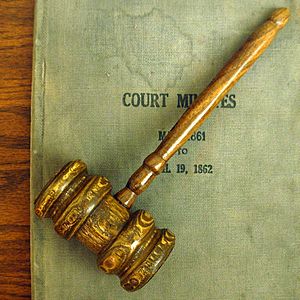Parliamentary procedure facts for kids
Parliamentary procedure is a special set of rules that groups use to have fair and organized meetings. These rules help everyone discuss ideas, share their opinions, and make decisions together. Think of them as the "game rules" for meetings, making sure things run smoothly and everyone gets a chance to speak.
Contents
The History of Meeting Rules
The idea of parliamentary procedure comes from the word "Parliament." A Parliament is a type of government where elected representatives make laws. The first rules for meetings started a long time ago in the British Parliament.
Back in the 1500s, people in the British Parliament began writing down how their meetings should work. Sir Thomas Smith even wrote a book about it in 1583! Some of the early rules they came up with were:
- Only one topic should be talked about at a time (started in 1581).
- People should not attack each other personally during debates (started in 1604).
- Discussions should stick to the main point of the topic (started in 1610).
- If a topic had different parts, they could be voted on separately (started in 1640).
Meeting Rules Around the World
Different countries have developed their own ways of running meetings.
Westminster Procedures
The "Westminster procedures" are meeting rules based on the British Parliament's system. Many countries that were once part of the Commonwealth, like Canada, Australia, New Zealand, India, and South Africa, still use these rules. For example, in Canada, their Parliament uses a big book called House of Commons Procedure and Practice to guide their meetings.
American Procedures
The United States Congress also developed its rules from the British system. However, they changed them over time. Now, many other countries, including Indonesia, the Philippines, Mexico, and South Korea, follow variations of the American parliamentary procedures.
Other Meeting Styles
Not all countries follow the British or American models. For example, the Diet of Japan (their Parliament) has different ways of doing things. After World War II, there were efforts to make Japan's rules more like America's. But in Japan, it's often more important for people to talk things out informally behind the scenes than to strictly follow formal meeting rules.
Robert's Rules of Order
In the United States, the most popular set of rules for meetings is called Robert's Rules of Order. Many different groups, from school clubs to city councils, use these rules to keep their meetings fair and organized.
Related pages
Images for kids
-
The European Parliament during a meeting in 2014.
See also
 In Spanish: Derecho parlamentario para niños
In Spanish: Derecho parlamentario para niños



